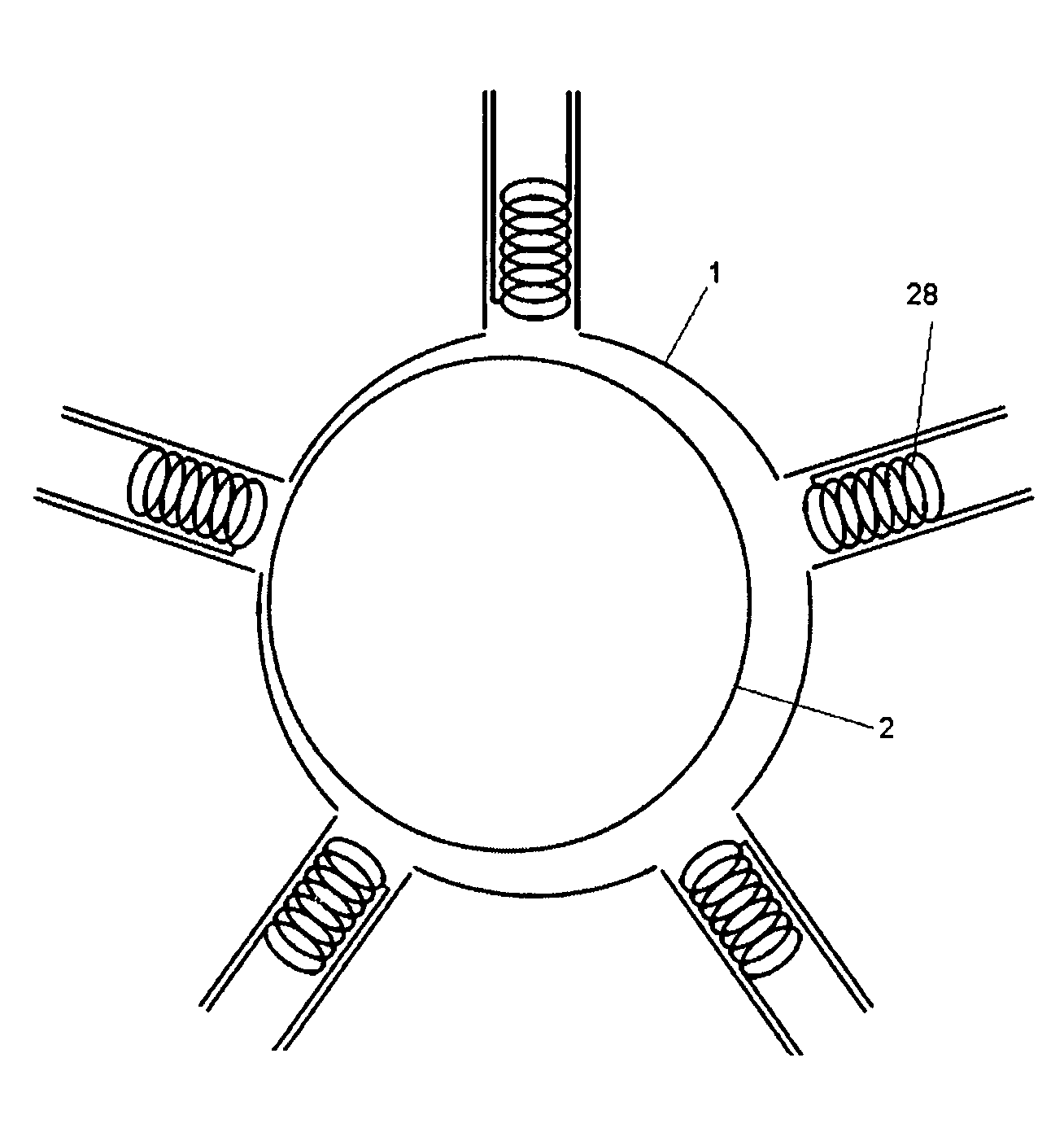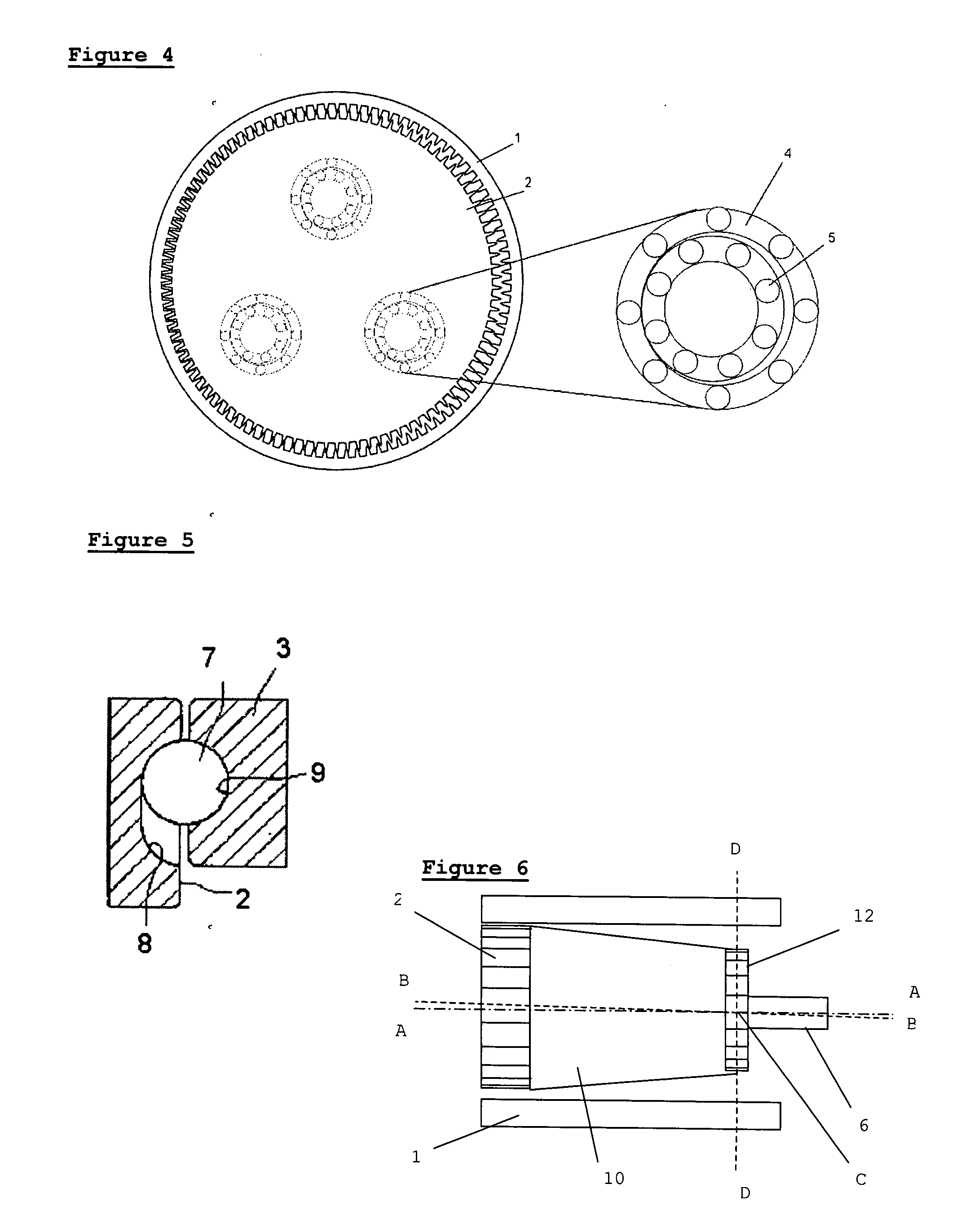Motor using magnetic normal force
- Summary
- Abstract
- Description
- Claims
- Application Information
AI Technical Summary
Benefits of technology
Problems solved by technology
Method used
Image
Examples
first embodiment
[0051] In the invention, a motor is disclosed, comprising a stator of high permeability material having a magnetic core, magnetic windings, and an internal cavity which is preferably cylindrical; and a rotor made from ferromagnetic materials with high permeability, situated inside the stator. Preferably, said rotor is internal to said stator and said rotor has an outer diameter significantly smaller than the inner diameter of the stator. The outer diameter of the rotor and the inner diameter of the stator have gear teeth so that the rotor and stator mesh as eccentric gears.
[0052] Preferably, said windings comprise a set of electrical coils positioned in slots, channels, or cavities in the high permeability material. The coils are arranged to induce a magnetic field in the high permeability material of the rotor and stator and any gap between, thereby creating magnetic attractive force between the rotor and the stator.
[0053] During operation, the stator windings are selectively and ...
second embodiment
[0089] In the invention, shown in FIG. 15, a motor comprises a stator 1 having a magnetic core, magnetic windings 22 (only one shown for clarity), and a cylindrical internal cavity; an eccentric rotor 2 eccentrically mounted inside the stator; and a flexible spline 30 (as known in the field of harmonic gearing), concentrically mounted inside the stator and coupled both to the rotor and to an output shaft 6. The motor is mounted on a bearing and can rotate.
[0090] During operation, the stator is magnetized in such a way that the rotor is pulled around the internal cavity of the stator, eccentrically oscillating at high frequency and rotating. Since the rotor is coupled to the spline, the spline rotates with the rotor but flexes to accommodate the eccentric oscillation of the rotor, thus only the rotation is transmitted by the spline to the output shaft. An advantage of this arrangement is that the motor can be integrally combined with the gearing.
[0091] Preferably, the internal surfa...
fourth embodiment
[0114] In the invention, shown in FIG. 18, a motor is disclosed, comprising a stator 1 having a magnetic core, magnetic windings, and a cylindrical internal cavity; and an eccentric ring gear rotor 37 made from magnetically attractive materials, situated inside the stator. The eccentric ring gear rotor has an outer diameter significantly smaller than the inner diameter of the stator and is internally and externally toothed. A smaller gear 38 is situated inside the ring gear rotor, concentric with the stator, mounted on the output shaft. The outer diameter of the smaller concentric gear 38 and the inner diameter of the stator 1 have gear teeth. The eccentric ring gear rotor 37 engages the stator on its outside and the smaller concentric gear on its inside. Thus the eccentric ring gear rotor connects the smaller concentric gear to the stator. In general, the gears are very similar in size, with the concentric gear 38 not much smaller than the innder diameter of the stator 1, and the r...
PUM
 Login to View More
Login to View More Abstract
Description
Claims
Application Information
 Login to View More
Login to View More - R&D
- Intellectual Property
- Life Sciences
- Materials
- Tech Scout
- Unparalleled Data Quality
- Higher Quality Content
- 60% Fewer Hallucinations
Browse by: Latest US Patents, China's latest patents, Technical Efficacy Thesaurus, Application Domain, Technology Topic, Popular Technical Reports.
© 2025 PatSnap. All rights reserved.Legal|Privacy policy|Modern Slavery Act Transparency Statement|Sitemap|About US| Contact US: help@patsnap.com



